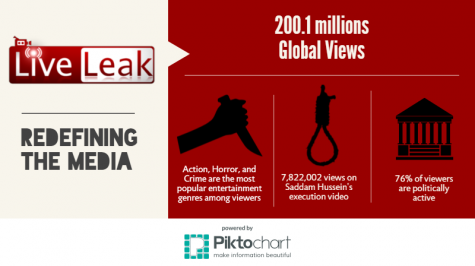Media Matters: Excessive violent media online leads to desensitization
Independent Journalism 101
In the picture above, a civilian films a bombing incident in Syria. While the rise in social media has ushered crowd-sourced journalism, the resulting saturation of violent content through platforms like LiveLeak can pose more harms than benefits.
April 13, 2016
After any tragedy, such as the bombing in Ankara on Mar. 13 or the terrorist attacks in Brussels on Mar. 22, one can expect to see a flood of information relating to the incident, condolences to victims and symbols of solidarity. However, there is some content that will never show up in a Facebook feed; graphically-violent, uncensored video has grown in popularity behind the scenes.
With over 15 million unique viewers worldwide, LiveLeak, a site known for previously publishing the executions of Saddam Hussein and James Foley online, has become more and more prolific, now releasing footage of conflicts in Ukraine and Syria.
Although LiveLeak serves as a hub for user-generated content, its violent content has become its signature; the site even keeps channels associated with major terrorist attacks.
People are often initially drawn to such graphic content due to its shock value. But as individuals see violence more often, their psychological response to the content begins to change.
Normally, humans react to violence through the fight or flight response. Graphic imagery resembles a threatening situation, so people display anxiety, arousal and concern when watching violence. Through repeated exposure to violence, however, viewers find violence less captivating.
Besides this desensitization, watching bombs, attacks and other forms of violence as entertainment brings up another ethical quandary. Sites like Liveleak enable people away from the incident to be awed by the events caught on camera. However, the videos are filmed in real time, a fact that eludes most viewers when they come across this kind of media on the web.
But as smartphones and cameras become more ubiquitous, the horrors of the world can be recorded, uploaded and shared like any other video. Founded in 2006 with a goal of encouraging crowd-sourced journalism, LiveLeak and similar sites provide a nearly regulation-free environment where terrorist attack footage and raw video clips of war appear like TV shows — real events trivialized to mere entertainment.
The victims in many graphic videos are made faceless and are injured or perish without their making a sound. As a result, the victims become dehumanized and no longer garner empathy from the audience. This phenomenon is explained well by this Brock University study.
In combination, these desensitizing effects make it more difficult for individuals who consume violent media to comprehend the scale of conflicts and logically respond to what they see. The life or death consequences of the conflict suddenly seem distant and unimportant.
Uncensored first-hand reporting does have a place in the world. For ordinary people to understand the struggles of those in regions of chaos, there needs to be communication. But having these videos become a constant source of violent imagery can cause more harm than good. For this reason, people online should be deliberate in choosing the content that they choose to share and view.



















![“[Building nerf blasters] became this outlet of creativity for me that hasn't been matched by anything else. The process [of] making a build complete to your desire is such a painstakingly difficult process, but I've had to learn from [the skills needed from] soldering to proper painting. There's so many different options for everything, if you think about it, it exists. The best part is [that] if it doesn't exist, you can build it yourself," Ishaan Parate said.](https://harkeraquila.com/wp-content/uploads/2022/08/DSC_8149-900x604.jpg)




![“When I came into high school, I was ready to be a follower. But DECA was a game changer for me. It helped me overcome my fear of public speaking, and it's played such a major role in who I've become today. To be able to successfully lead a chapter of 150 students, an officer team and be one of the upperclassmen I once really admired is something I'm [really] proud of,” Anvitha Tummala ('21) said.](https://harkeraquila.com/wp-content/uploads/2021/07/Screen-Shot-2021-07-25-at-9.50.05-AM-900x594.png)







![“I think getting up in the morning and having a sense of purpose [is exciting]. I think without a certain amount of drive, life is kind of obsolete and mundane, and I think having that every single day is what makes each day unique and kind of makes life exciting,” Neymika Jain (12) said.](https://harkeraquila.com/wp-content/uploads/2017/06/Screen-Shot-2017-06-03-at-4.54.16-PM.png)








![“My slogan is ‘slow feet, don’t eat, and I’m hungry.’ You need to run fast to get where you are–you aren't going to get those championships if you aren't fast,” Angel Cervantes (12) said. “I want to do well in school on my tests and in track and win championships for my team. I live by that, [and] I can do that anywhere: in the classroom or on the field.”](https://harkeraquila.com/wp-content/uploads/2018/06/DSC5146-900x601.jpg)
![“[Volleyball has] taught me how to fall correctly, and another thing it taught is that you don’t have to be the best at something to be good at it. If you just hit the ball in a smart way, then it still scores points and you’re good at it. You could be a background player and still make a much bigger impact on the team than you would think,” Anya Gert (’20) said.](https://harkeraquila.com/wp-content/uploads/2020/06/AnnaGert_JinTuan_HoHPhotoEdited-600x900.jpeg)

![“I'm not nearly there yet, but [my confidence has] definitely been getting better since I was pretty shy and timid coming into Harker my freshman year. I know that there's a lot of people that are really confident in what they do, and I really admire them. Everyone's so driven and that has really pushed me to kind of try to find my own place in high school and be more confident,” Alyssa Huang (’20) said.](https://harkeraquila.com/wp-content/uploads/2020/06/AlyssaHuang_EmilyChen_HoHPhoto-900x749.jpeg)











